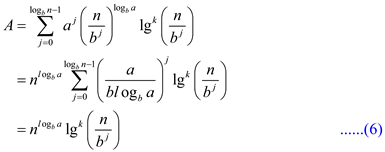The equation of the recursive division of the recursion tree when b is a positive number, which represents the size of the sub problem, is each of a number of sub problems.
At every upcoming step, each of a divided problem divides
themselves by size .
.
Therefore, the equation for finding the  element in
a sequence of n numbers where b’s value is only
restricted to any positive value is as:
element in
a sequence of n numbers where b’s value is only
restricted to any positive value is as:
 …… (1)
…… (1)
In equation (1) put the value of j
For 

For 
 …… (2)
…… (2)
Put the value of  in equation
(2)
in equation
(2)
So,

For 
 …… (3)
…… (3)
Put the value of  in equation
(3)
in equation
(3)
So,


Similarly calculate the value of 
The general equation for equation (1) is as follows:
 …… (4)
…… (4)
In general equation (4) put the integer value of j to find the
value of  similar to
the value of equation (1), (2), (3) and so on.
similar to
the value of equation (1), (2), (3) and so on.
Consider the following equation.


From equation (4.22) given in lemma 4.3 in the text book, a
function  is defined
over exact powers of b by,
is defined
over exact powers of b by,

Substitute  in equation
(1).
in equation
(1).
Then,

Substitute the value of  from
equation (3) in equation (2).
from
equation (3) in equation (2).
Then,

Consider  as A in
equation (4).
as A in
equation (4).
Then,


Consider  as B in
equation (6).
as B in
equation (6).
Then,

Consider  as d
in
as d
in  .
.
Then,


Substitute equation (7) in equation (5).
Then,

Substitute equation (9) in equation (10).
Then,

Hence, proved that if , then the
master recurrence has solution
, then the
master recurrence has solution  .
.
There are certain conditions for implementing the Master’s
theorem, that is,  has to be a
monotonically increasing function; and
has to be a
monotonically increasing function; and  must be a
polynomial function.
must be a
polynomial function.
Now from the above recurrence relation, we can find the mathematical relation as:
 … … (2)
… … (2)
Taking  in equation
(2)
in equation
(2)

 … … (3)
… … (3)
Dividing equation (3) by 


.
.
.
 … … (4)
… … (4)
By adding the equations (2) through (4), we get the following result.
 …
… (5)
…
… (5)
There are 3 cases of the master’s theorem for equation (5).
1. 
2. 
3. 
For case 3 of the proof of the master theorem is as follows:
If 


Therefore 
Thus in general if  where
where
 and
the condition is
and
the condition is
 For
some
For
some then,
then,

In the third case, the in the
recurrence relation is actually compared to an
in the
recurrence relation is actually compared to an ; if
; if
 is
greater than
is
greater than  by a factor
of log, this condition has to be there, else the
by a factor
of log, this condition has to be there, else the  function
might be equal to the growth of
function
might be equal to the growth of .
.
So the condition of  must be
there.
must be
there.
Thus, the statement of case 3 of the masters theorem is
overstated to have the regularity of  to be there
for
to be there
for  then
the
then
the .
.